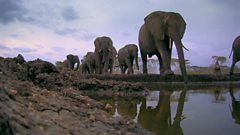Episode 1
In a groundbreaking natural history event, remote cameras capture life at a specially built African waterhole. Which animals find it, how do they use it, and will they share?
Waterholes are vital to the African ecosystem as bustling oases where elephants, lions, leopards and hundreds of other species meet and compete for water. But little is known about how they support so much life. Now the 大象传媒 Studios Natural History Unit is working with Mwiba Wildlife Reserve in Tanzania to create the world鈥檚 first waterhole with a built-in specialist camera rig.
With half-submerged and weatherproofed remote cameras, Chris Packham and biologist Ella Al-Shamahi aim to uncover the complex dynamics of the waterhole for the very first time. They film across three dramatic periods: the middle of the dry season, the hottest time of year and the height of the first rains, to gain unique insights into the lives of some of Africa鈥檚 most iconic animals and uncover the increasingly important role of water in Africa with the growing impact of climate change.
In this first episode, the waterhole is built in the middle of an open patch of savannah to enable wildlife to approach it from all directions. The team excavate 100 tonnes of soil and lay eight kilometres of fibre optic cable and piping. Sixty thousand litres of sustainable groundwater is pumped in, filling two pools - thus giving more water edges for thirsty animals to access. At the beginning of the dry season, the new waterhole is open for business, and the cameras are rolling. As demand for fresh water builds, the team wants to find out which animals will come, if they share, and how many species in total use this precious new water source. Within the first hour, warthogs and elephants discover this new oasis, and soon a cast of wild animal characters keep coming back.
Ella uncovers the surprising schedule for a day at the waterhole, and Chris uses state-of-the-art thermal cameras to reveal how different species thermoregulate to survive. With each day, the landscape becomes drier, and soon tensions are rising between the two biggest drinkers: elephants and cape buffalo. Is there enough room at the waterhole for these two African giants? While more animals gather at the waterhole, wildlife cameraman Bob Poole is looking into the effect it is having on the wider landscape, including the resident big cat population. Predators do not need to drink water regularly, but it is thought they use waterholes as hunting grounds during the dry season. As leopard and lion close in, the waterhole becomes a dangerous place to be, and the wild community of regular drinkers must risk life and death with each visit.
Last on
More episodes
Previous
You are at the first episode
Next
Clips
-
![]()
Spa day at the waterhole
Duration: 03:01
-
![]()
Specialist cameras record life at a new African waterhole
Duration: 02:24
-
![]()
A first glimpse of the waterhole lion pride's new cubs
Duration: 01:40
-
![]()
A surprising hierarchy develops at the new waterhole
Duration: 02:52
Credits
| Role | Contributor |
|---|---|
| Presenter | Chris Packham |
| Presenter | Ella Al-Shamahi |
| Executive Producer | Roger Webb |
| Series Producer | Anwar Mamon |
Broadcasts
- Fri 4 Dec 2020 21:00
- Sat 5 Dec 2020 09:00
- Thu 17 Dec 2020 03:15
- Wed 29 Dec 2021 07:40
- Sat 14 Jan 2023 17:30大象传媒 Two Northern Ireland HD & Northern Ireland only
- Sat 14 Jan 2023 18:00大象传媒 Two except Northern Ireland & Northern Ireland HD
- Sat 7 Sep 2024 11:00
- Mon 16 Sep 2024 08:00
- Mon 2 Jun 2025 15:45





